The major averages were mixed. The S&P 500 (SPX) index showed a slight gain of +0.32% for the week, states Bonnie Gortler of bonniegortler.com.
Only three sectors were stronger than SPDR S&P 500 ETF Trust (SPY). Consumer Discretionary (XLY) and Technology (XLK) were the strongest sectors, while Financials (XLF) and Energy (XLE) were the weakest.
S&P SPDR Sector ETFs Performance Summary 11/12 - 11/19/21
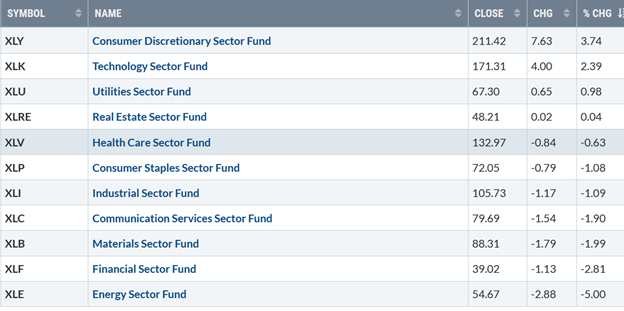
Source: Stockcharts.com
Figure 2: ETFs Bonnie's Following Closely Performance Summary
11/12/21 – 11/19/21
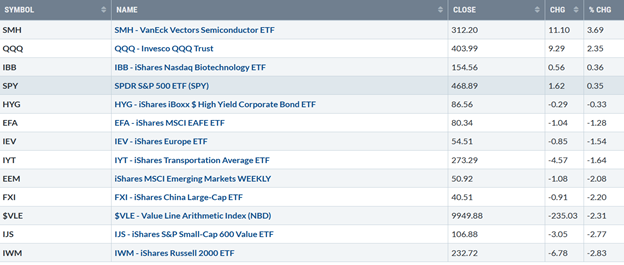
Source: Stockcharts.com
Semiconductors (SMH) remained strong, leading the Technology stocks higher. Small Cap Value and Small Cap Growth lagged, falling over 2%. China (FXI), after a big move the previous week, failed to follow through to the upside. However, a buying opportunity remains (Figure:12).
The Dow was the weakest major average falling -1.38%, its second losing week in a row. The S&P 500 gained +0.32%, while Nasdaq was up +1.24%. The Russell 2000 Index fell -2.85%, underperforming for the second week in a row after breaking out of its trading range.
Weekly market breadth deteriorated on both the NYSE and Nasdaq. The New York Stock Exchange Index (NYSE) had 1034 advances and 2491 declines. Nasdaq had 1512 advances and 3479 declines.
Figure 3: 10-Year US Treasury Yields
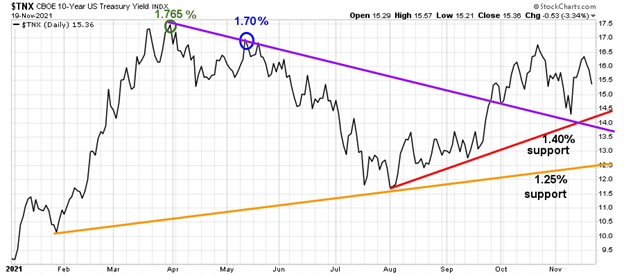
Source: Stockcharts.com
10-Year US Treasury yields rose, closing at 1.536%, up from 1.453% the previous week but below April’s highs (Figure 1). Support remains between 1.25% and 1.40%. Resistance is between 1.65% and 1.80%. A close above or below resistance is likely to cause volatility in the equity and bond market. Yields remaining in a trading range through the end of the year would be ideal.
Figure 4: Daily New York Stock Exchange (NYSE) New Lows
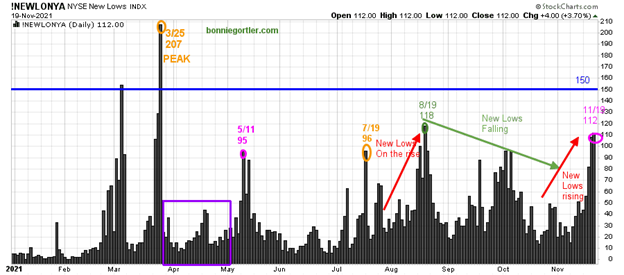
Source: Stockcharts.com
New lows on the NYSE peaked at 207 (orange circle) on 3/25/21. New lows then contracted (purple rectangle) before rising to 95 on 5/11, 96 on 7/19, and another peak of 118 on 8/19 (green circle).
Watching new lows on the New York Stock Exchange is a simple technical tool that helps awareness about the immediate trend's direction.
Learn more in my book, Journey to Wealth. Here is an excerpt, "If the new lows are above 50, it is an alert or warning of possible market weakness, or a change in market tone. Be aware, it’s a good idea to make sure you are happy and comfortable with your portfolio. It is best not to have more volatile investments than you can handle where you feel uncomfortable. If the selling continues, you could have some serious losses occurring if the market falls further. When new lows are above 150, the market is negative, higher risk, selling is taking place. Sometimes it could be severe, and sometimes on a very nasty day, you can have 'panic selling,' and big wild swings (high volatility) to the downside may occur."
New lows are rising, closing at 112 (pink circle) last week, its highest reading since October, and no longer in a low-risk zone.
Further expansion of new lows to close above 150 would be negative (blue line) and imply a bumpy road ahead.
Figure 5: The Value Line Arithmetic Average
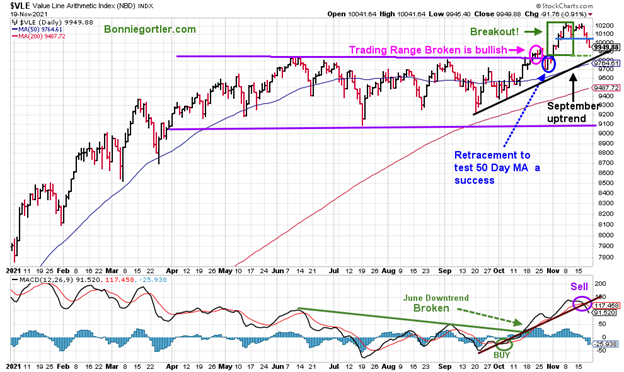
Source: Stockcharts.com
The Value Line Arithmetic Average (VLE) is a mix of approximately 1700 stocks. VLE broke out of its trading range (pink circle) after a successful test of the 50-day moving average at the end of October. VLE fell sharply -2.31% last week as the broad market moved lower on poor market breadth. As long as VLE remains above the breakout, the likelihood of a deep correction is unlikely.
MACD (lower chart), a momentum indicator, gave a sell. The odds favor another rally attempt will occur because MACD confirmed the high made in the VLE.
Figure 6: Daily Nasdaq Advance-Decline Line
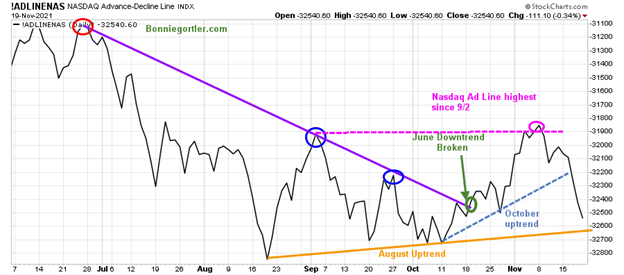
Source: Stockcharts.com
The daily Nasdaq AD-Line failed to get through the June downtrend (purple line) and turned down in September, making lower highs. The Nasdaq AD-Line made a higher low in October, holding above the August lows (orange arrow), and turned up. The first week of November, the AD-Line rose sharply to its highest level since 9/2, not getting through resistance and then turned down.
The AD-Line was lousy last week, as Nasdaq rose on negative breadth. The October uptrend (blue dotted line) was broken. The moment of truth has arrived. It appears another test of August lows is in process. A turn-up now would be bullish. On the other hand, a close below the August uptrend would be negative, implying weakness in Nasdaq is forthcoming.
Figure 7: Transportation Average
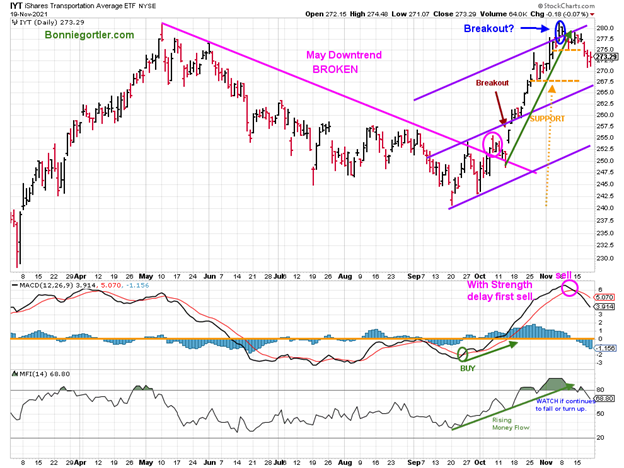
Source: Stockcharts.com
The Transports (IYT) rose in October, but came under some selling pressure in November after meeting its first upside objective. IYT closed at 273.29, down -1.64%, breaking the October uptrend. Support is 267.50, followed by 252.05. Resistance is 275.00, followed by 280.00, with an upside objective to 287.50.
MACD (middle chart) remains on a sell. However, since MACD confirmed the high made in IYT, I’m expecting another rally is likely before a significant correction.
Money Flow (bottom chart) also confirmed the strength in IYT and is falling after breaking the September uptrend. Continue to watch the money flow if it weakens or starts rising again.
Figure 8: Daily iShares Russell 2000 (IWM) Price (Top) and 12-26-9 MACD (Middle and Money Flow (Bottom)
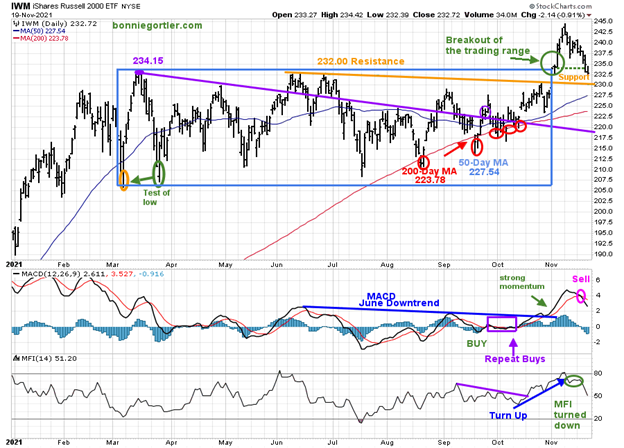
Source: Stockcharts.com
The top portion of the chart is the daily iShares Russell 2000 Index ETF (IWM), the benchmark for small-cap stocks, with a 50-day moving average (MA) (blue line) and 200-Day Moving Average (MA), that traders watch and use to define trends.
IWM made a low on 3/5, then peaked at 234.15 (purple circle), followed by declines to test the March lows and the March high. There were five penetrations of the 200-day moving (red circles) within the trading range (blue rectangle). However, none triggered major selling.
A disappointing week for small caps. After breaking out of their trading range, IWM came to a halt. The bulls vanished in the past two weeks. IWM closed sharply lower at 232.72, down -2.83%, slightly below support at 234.00. Next support is 230.00, followed by 225.00. Resistance is at 240.00.
The upside objective remains at 259.00.
MACD (middle chart) broke the early June downtrend (blue line) and gave repeat buys in August, September, and October, as IWM stayed in the trading range. MACD is on a sell. With the power of the upside move, the first MACD sell is likely not to be the final high, and another rally could begin as soon as this week.
Money Flow (lower chart) also weakened and is falling. Watch MFI for when it turns up for a clue IWM is ready to advance.
Figure 9: Daily Invesco QQQ Trust Nasdaq (QQQ) Price (Top) Money Flow (Middle) and 12-26-9 MACD (Bottom)
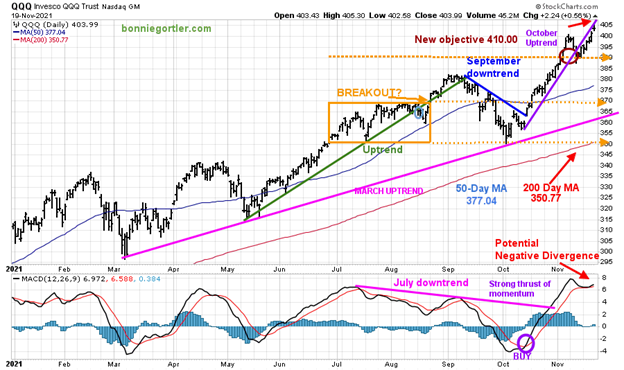
Source: Stockcharts.com
The chart shows the daily Invesco QQQ, an exchange-traded fund based on the Nasdaq 100 Index with its 50-day moving average and 200-day moving average. In June, QQQ was in a trading range (orange rectangle) and then broke out above 370.00 in August, which failed. A decline followed to 350.00 support in late September.
The March uptrend (top chart) remains intact (pink line). After breaking the short-term downtrend from 10/7 (blue line), QQQ continued to climb in November.
QQQ closed at 403.99, continues to be strong, up +2.35%, with Apple (AAPL), its largest holding, making a new 52 week high, fueling the advance. QQQ is close to its upside target of 410.00, so be alert to a possible pause or consolidation.
Support remains at 390.00, followed by 380.00, and 370.00.
The lower chart is MACD (12, 26, 9), a measure of momentum. MACD gave a timely buy signal. MACD made a new high, strong thrust of momentum after breaking the July downtrend. Last week, I alerted you that the first MACD sell is likely not to be a serious correction. A period of consolidation may be necessary. The second sell when and if it occurs should be followed.
With the rise in QQQ, MACD moved sideways and did not give a sell. However, a potential negative divergence has formed where QQQ made a higher high and MACD a lower high. Therefore, if MACD does not make a higher high, take the next MACD sell when given.
Figure 10: Van Eck Semiconductors (SMH) Daily
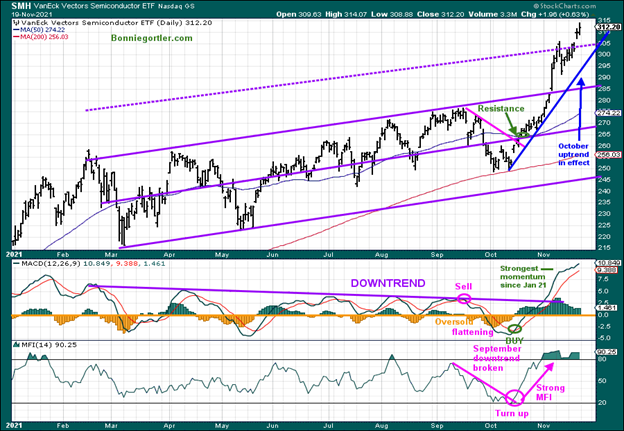
Source: Stockcharts.com
The October uptrend remains intact. The SMH rally has been explosive, leading the technology sector higher. SMH for the week was up +3.69%, closing at 312.20. The next objective is 322.00. Support is 305.00 followed by 296.00 and 285.00.
MACD (middle chart) remains on a timely buy, with momentum accelerating to the upside after breaking the February downtrend (purple line), confirming the breakout in SMH. Money flow (lower chart) remains strong. It will be bullish if SMH continues to lead, stronger than the Nasdaq and S&P 500, while closing above 305.00 support and above the October uptrend (blue line).
Figure 11: ARKK Innovation
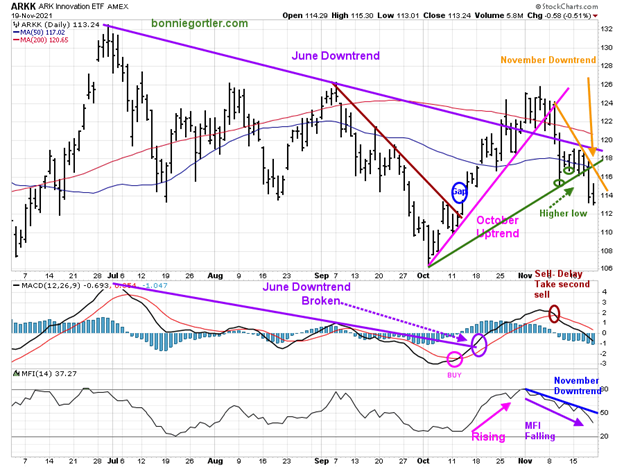
Source: Stockcharts.com
ARK Innovation ETF (ARKK), an actively managed ETF by Cathie Wood that seeks long-term growth. ARKK broke its September short-term downtrend (brown line), gapped up, and then rallied. The previous week, ARKK broke below the October uptrend (pink line) but remained above the gap (blue circle) and turned up, which was a positive sign. ARKK had a higher low formation develop (green circles) but had no strength and turned lower. Last week, stocks in ARKK fell sharply. ARKK dropped -4.43%, and a new downtrend started.
MACD gave a sell and made a higher high, implying it's okay to delay the first sell, but take the second. Delaying the sell did not work out, as ARKK didn’t hold support at 116.00 or 114.00 after breaking the October uptrend (green line). The bears are now in control until the downtrend is broken.
Resistance is at 118.00 followed by 120.00.
Money flow (lower chart) continues trending down. Watch money flow for a turn-up. When MFI breaks the November downtrend, this will imply another leg up is possible.
In last week's update, I mentioned a potential buying opportunity in China.
Potential Buying Opportunity in China Remains
Figure 12: Daily iShares China Large-Cap ETF FXI (Top)
iShares China Large-Cap Relative Strength Ratio (FXI)/S&P500 (SPY) Bottom
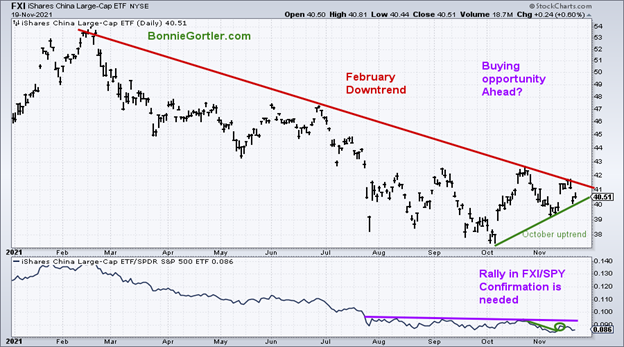
Source: Stockcharts.com
A buying opportunity could be developing even though China did not follow through to the upside last week. The October uptrend remains intact (green line top chart). FXI could break the February downtrend (red line) with solid gains this week. I like the pattern of higher lows in the price spread over several weeks.
The relative strength ratio in the lower chart broke its October short-term downtrend (green line), a positive sign. The FXI/SPY ratio did not make a new relative strength low on the pullback, also a positive sign. However, the FXI/SPY ratio needs to show more strength for confirmation. You want to see a breakout of the trading range (purple line).
Note: FXI is high volatility - high risk.
Figure 13: New York Stock Exchange AD-Line
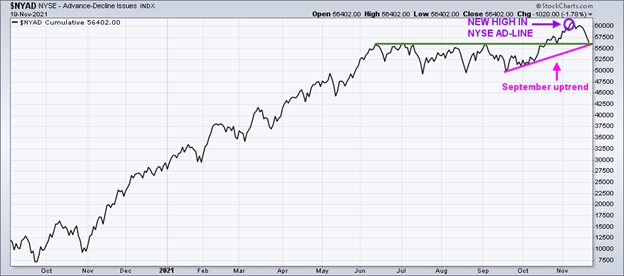
Source: Stockcharts.com
In the top portion of the chart (Figure:13), the NYSE A/D line made a new high on 11/8/21; but since then, it has fallen, is now at key support, and needs to hold. A break in the September uptrend in the AD-Line would be negative. However, a turn up now, along with a new high, would be bullish. Historically, the market rarely makes a final peak when the cumulative advance-decline line makes a new high.
Summing Up:
Semiconductors and Technology stocks continued their winning ways. Market breadth deteriorated, and the rally is supported by fewer stocks rising. New lows have increased on the NYSE and Nasdaq, which is worrisome. Momentum has slowed to the upside. However, the power of the advance that has occurred is strong enough to imply the final high has not been achieved. Key support on the Russell 2000, Value Line Arithmetic Index, and Transports is slightly below Friday’s close. Investors are concerned about inflation, when interest rates will begin rising, the decision of who the Fed Chair will be, and economic data to be released this week. Favorable holiday seasonality is now. Historically, stocks have tended to do well during the week of Thanksgiving. The trend remains up. Continue to give the benefit of the doubt to the bulls. However, be alert to a trend change if market breadth doesn’t improve immediately and support levels don’t hold.
Remember to manage your risk, and your wealth will grow.
I would love to hear from you. If you have any questions or comments or would like to talk about the market, email me at Bonnie@Bonniegortler.com.
Disclaimer: Although the information is made with a sincere effort for accuracy, it is not guaranteed that the information provided is a statement of fact. Nor can we guarantee the results of following any of the recommendations made herein. Readers are encouraged to meet with their own advisors to consider the suitability of investments for their own particular situations and for determination of their own risk levels. Past performance does not guarantee any future results.





















